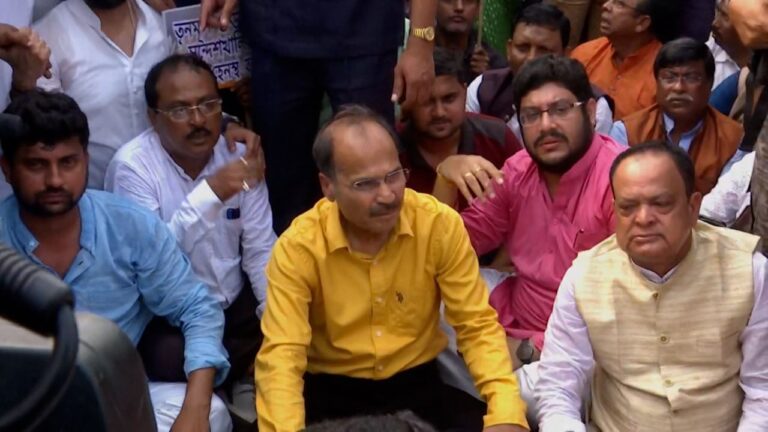News Desk, Kolkata : In the scorching heat once again, the political landscape in West Bengal witnessed a dramatic turn on Thursday when the opposition leader Shubhendu Adhikari marched towards the state legislative assembly. Despite encountering multiple police barricades on his way, Shubhendu, along with lawmakers Tapsi Mandal, Chandana Bauri, and Shankar Ghosh, managed to reach Sarberia. However, further progress was thwarted as they faced police resistance.
Engaging in a verbal tussle with the police, Shubhendu found himself detained in Rampur. The Central High Power Committee, stationed in the Nasakarpara area, staged a protest by sitting on the road, emphasizing their discontent. Meanwhile, Adhir Chowdhury, the Pradesh Congress President, attempted to lead a procession towards Sandeshkhali, but was also stopped.
In the midst of this political turmoil, the Central Committee stated that Section 144 had been imposed in several areas as a precautionary measure. If the opposition group enters the villages, it could lead to a breach of law and order. The committee suggested that if Section 144 is in effect, the four individuals should be allowed to proceed, but the police were reluctant, leading to ongoing tensions.
Reacting to the situation, MLA Agnimitra Paul remarked, “Trinamool ministers can enter the village, but not the central ministers! This is Bengal. The power of suppression is being exercised.”
Union Minister Annapurna Devi expressed her dissatisfaction with the police’s role, stating, “If I see the role of the police, it would have been better if they had shown such commitment in the case of Sheikh Shahjahan’s arrest. Then there would have been no need for this.”
BJP MP Dilip Ghosh commented on the unfortunate events in Mamata’s state, saying, “In Mamata’s state, such unfortunate incidents are happening; she is trying to suppress it. If there is nothing wrong, why not let them go?”
The current situation in the area remains tense, with clashes between the police and members of the Central Team escalating. The heat of the moment has stirred verbal confrontations between the two sides.
As the day unfolds, the political landscape takes another turn with Congress making its move towards Sandeshkhali. Under the leadership of Pradesh Congress President Adhir Chowdhury, Congress representatives attempted to enter the village, but their path was obstructed by the police. A standoff ensued, with Congress leaders getting entangled in a heated exchange with law enforcement.
The saga continues, with Sandeshkhali becoming the epicenter of political friction. The narratives of various political leaders intertwine, creating a complex web of conflicting interests and power dynamics. The scorching heat seems to mirror the rising tensions, and the unfolding events keep the region on edge.
In the midst of this political theater, the people of Sandeshkhali find themselves caught between the power play of political leaders and the assertiveness of law enforcement. As the drama unfolds on the streets, the true impact on the lives of the residents remains uncertain.
The saga of Sandeshkhali reflects the larger political landscape in West Bengal, where power struggles, arrests, and protests have become commonplace. The echoes of dissent resonate through the narrow lanes, and the political heat shows no signs of abating.
In this political theater, the actors change, but the script remains one of contention and resistance. The scorching heat of West Bengal becomes a metaphor for the heated political climate, where the quest for power and control takes center stage, leaving the people of Sandeshkhali as mere spectators in this unfolding drama.
DISCLAIMER
Our news media denounces any form of bias and disapproves of sensationalism. The disseminated news is entirely educational and aimed at social awareness. Our media maintains absolute impartiality, adhering solely to the purpose of education and social consciousness.


